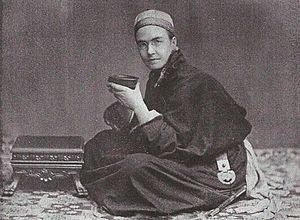
Today’s Leader of Faith
SUSANNA CARSON RIJNHART
Home Call : 07 Feb 1908
Doctor, Medical Missionary, Evangelist, Great Brave Warrior.
Susanna Carson Rijnhart (1868–1908) was a pioneering Canadian physician and medical missionary from Chatham, Ontario. Despite facing personal loss, harsh conditions, and dangerous circumstances, she remained committed to her mission. Her travels to Tibet and China, though fraught with challenges, represented the perseverance of early female missionaries who ventured into uncharted territories. Through her writings and lectures, she shared her experiences, inspiring others with her determination.
Susie Carson, born in 1868 in Chatham, Ontario, graduated as a medical doctor from Trinity College, Toronto, at twenty. She and her sister, Dr. Jean Carson, were the first female physicians admitted to practice in Western Ontario. After six years in private practice, Susie, a Methodist since sixteen, became active in various Christian organizations, later working with the Disciples of Christ. She Susie married Petrus Rijnhart in 1894 and left for China as an independent missionary. The couple relied on funds raised in Canada, despite criticism that independent missionaries were unpredictable.
In 1895, the Rijnharts and their colleague William Ferguson arrived in Lusar, near the Kumbum Monastery, to learn Tibetan and work among Tibetans, aiming eventually to reach Lhasa. After Ferguson left, they tended to the wounded during a Muslim revolt and were invited to reside at the monastery, where Petrus befriended the abbot. In 1896, they moved to Tankar to open a medical dispensary, earning a living through small medical fees. Rijnhart along with her husband arrived in Lusar, Tibet, in 1895 to work among Tibetans. She focused on learning Tibetan and providing medical care. During a Muslim revolt in 1896, she treated the wounded at Kumbum Monastery and was later invited to reside there. She then moved to Tankar, where she opened a medical dispensary, offering healthcare services to the local population. Despite hardships, she gained the trust of the Chinese and Tibetan communities. Explorer Sven Hedin praised her for winning friends through her medical skill. In 1898, Susie, her husband, and their infant son set out for Lhasa with supplies and Tibetan Bibles. After two months, their hired men deserted, their pack animals were stolen, and baby Charles died. Blocked by Tibetan officials, they were forced to take a dangerous route east. On September 17, bandits attacked, wounding a guide and stealing most of their horses. Left stranded, they abandoned supplies and pressed on. On September 26, Petrus left to seek help and never returned. Alone, Susie defended herself with a revolver, evaded assault, and secured a monastery passport. Enduring harsh conditions, she arrived in Kangding on November 26, 1898; penniless, frostbitten, and in rags, where she found refuge with China Inland Mission missionaries.
After losing her son and husband, she returned to Canada, wrote about her experiences, and later resumed missionary work in China. Despite health struggles, she remained dedicated to her mission, becoming one of the few Western women to journey deep into Tibet. She passed away on February 7, 1908, at the age of 40, in Chatham, Ontario. Her legacy highlights the perseverance of early female missionaries in challenging and often hostile environments.
